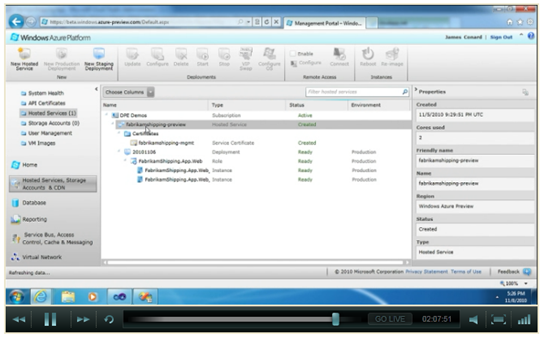What was talked about at TechEd Europe today?
Hyper-V Cloud
Hyper-V Cloud is IaaS (Infrastructure as a Service) for your own private use, you own and manage the hardware and the software. Furthermore we’ve announced partners who’ve produced hardware reference architectures (Fast Track) which you can buy direct from them to accelerate the process of building your own cloud. One example is from HP, but there are others from Dell, NEC and Hitachi as well as others. So what do you need to build your own, well Windows Server 2008 R2 Hyper-V, System Center and the Virtual Machine Manager Self Service Portal. For a deployment guide take a look here and you’ll get best practice for doing private cloud deployment.
Not only that but market share for Hyper-V is up by 12% which means that even more people are trusting Hyper-V.
System Center and Private Clouds
We saw a demo of the next version of System Center which has a new console (not an MMC). Server App-V, where applications on the server are virtualised, was introduced along with the features of System Center that allow you to design an application as a service using templates so that an application owner can provision their own application in just a few clicks but in a way that allows administrators to control the deployment. What System Center does is move an application from a stand alone unit to an elastic service. It’s a true private cloud.
Windows Azure and System Center
Much of what I explained in my PDC wrap up was covered again from the IT Pro perspective System Center will help you manage both in the future. The image at the top of this post is the new Azure portal, which opens up all the features in that post. One of the demos showed how ANY application written for Azure with .NET can be instantly monitored by System Center with almost Zero effort, allowing almost instant application level tracing. What this means is you can suddenly tell your dev guys why the whizzy application they created is running slow. It’s also possible to monitor SQL Azure databases from System Center too and you can view them in the context of your network, that is along side your own services.
There was also some clarification around our thinking of Paas and Iaas
Windows Server = IaaS
Windows Azure = PaaS
RemoteFX and Dynamic Memory
Windows Server 2008 R2 SP1 and Windows 7 SP1 in Q1 2011. With this we get RemoteFX which will deliver a full fidelity Windows 7 experience in VDI (virtual desktop infrastructure) and with Dynamic Memory it’s possible to achieve even higher server density as you can over commit the amount of memory the server has. Say it has 8gb of RAM, you can tell each VM it has 8GB.
Windows Intune
To be released in 2011 provides remote management of your entire desktop and laptop estate without rolling out management infrastructure. I love Windows Intune.
Forefront Endpoint Protection 2010
Will be fully integrated with System Center and released in early 2011.
Office 365
We saw awesome demos of how simple it is to setup and run your business from the cloud with Office 365.
Over the course of the week Andrew @deepfat Fryer and I will be blogging other goings on at TechEd Europe
